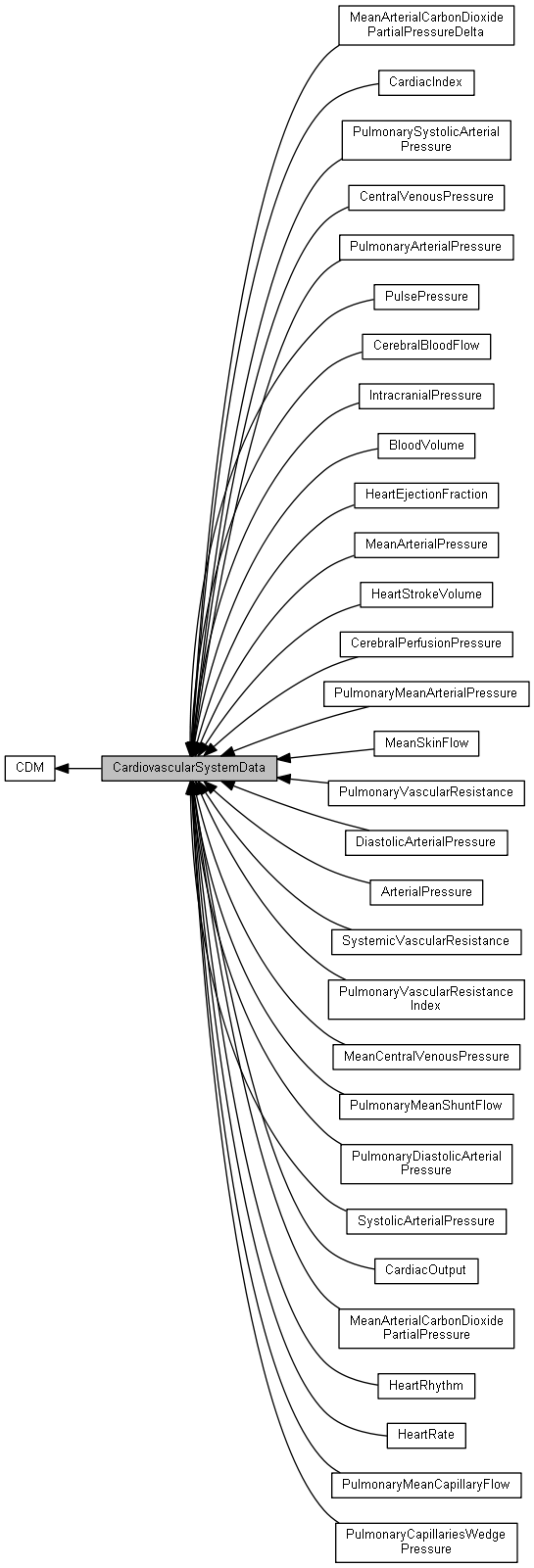Provides a representation of the human vasculature. More...
Collaboration diagram for CardiovascularSystemData:

|
Modules | |
| ArterialPressure | |
| The current arteial pressure. | |
| BloodVolume | |
| The total volume of fluid within the cardiovascular system. | |
| CardiacIndex | |
| Relates heart performance to the size of the individual. | |
| CardiacOutput | |
| The volume of blood being pumped from the heart in a given time interval. It is defined as the heart rate multiplied by the stroke volume. | |
| CentralVenousPressure | |
| The instantaneous pressure of the venous return. | |
| CerebralBloodFlow | |
| The rate of blood flow into the skull, thus supplying the brain. | |
| CerebralPerfusionPressure | |
| The difference between the mean arterial pressure and the cerebral blood pressure. Defines the hydrostatic diffusion gradient. | |
| DiastolicArterialPressure | |
| The minimum pressure in the aorta over the course of a cardiac cycle. | |
| HeartEjectionFraction | |
| The current pressure in the aorta. | |
| HeartRate | |
| The fraction of the blood that is pumped out of the ventricle during a cardiac cycle. | |
| HeartRhythm | |
| Current heart rhythm. | |
| HeartStrokeVolume | |
| The volume of blood pumped from the left ventricle in one contraction. | |
| IntracranialPressure | |
| The pressure inside the skull. Equal to the cerebral blood pressure with the cerebrospinal fluid pressure being assumed equal. | |
| MeanArterialPressure | |
| The average arterial pressure throughout each cardiac cycle. | |
| MeanArterialCarbonDioxidePartialPressure | |
| The mean of the partial pressure of carbon dioxide in the aorta over a cardiac cycle. | |
| MeanArterialCarbonDioxidePartialPressureDelta | |
| The change of the the mean of the partial pressure of carbon dioxide in the aorta from the previous cardiac cycle. | |
| MeanCentralVenousPressure | |
| The average pressure in the vena cava over the course of a cardiac cycle. | |
| MeanSkinFlow | |
| The blood flow to the skin averaged over the current cardiac cycle time. | |
| PulmonaryArterialPressure | |
| The current pressure in the pulmonary arteries. | |
| PulmonaryCapillariesWedgePressure | |
| The pressure within the pulmonary capillaries. | |
| PulmonaryDiastolicArterialPressure | |
| The minimum pressure that occurs in the pulmonary arteries over the course of a cardiac cycle. | |
| PulmonaryMeanArterialPressure | |
| The average pressure that occurs in the pulmonary arteries over the course of a cardiac cycle. | |
| PulmonaryMeanCapillaryFlow | |
| The average blood flow in the pulmonary capillaries over the course of a cardiac cycle. | |
| PulmonaryMeanShuntFlow | |
| The average blood flow diverted from the pulmonary capillaries (not oxygenated) over the course of a cardiac cycle. | |
| PulmonarySystolicArterialPressure | |
| The maximum pressure in the pulmonary arteries over the course of a cardiac cycle. | |
| PulmonaryVascularResistance | |
| The resistance offered by the pulmonary circulation. | |
| PulmonaryVascularResistanceIndex | |
| Relates pulmonary circulation performance to the size of the individual. | |
| PulsePressure | |
| The difference between the systolic and diastolic pressures. | |
| SystemicVascularResistance | |
| The resistance to blood flow through the entire systemic vasculature, not including the pulmonary circulation. | |
| SystolicArterialPressure | |
| The maximum pressure in the aorta over the course of a cardiac cycle. | |
Detailed Description
Provides a representation of the human vasculature.
The heart is the driving force that creates blood flow through the cardiovascular system. The resulting blood flow is utilized by other physiologic systems as a means of transporting the oxygen, carbon dioxide and other substances throughout the human body.





